Gregory R. Ganger
Nonuniform-Tensor-Parallelism: Mitigating GPU failure impact for Scaled-up LLM Training
Apr 08, 2025



Abstract:LLM training is scaled up to 10Ks of GPUs by a mix of data-(DP) and model-parallel (MP) execution. Critical to achieving efficiency is tensor-parallel (TP; a form of MP) execution within tightly-coupled subsets of GPUs, referred to as a scale-up domain, and the larger the scale-up domain the better the performance. New datacenter architectures are emerging with more GPUs able to be tightly-coupled in a scale-up domain, such as moving from 8 GPUs to 72 GPUs connected via NVLink. Unfortunately, larger scale-up domains increase the blast-radius of failures, with a failure of single GPU potentially impacting TP execution on the full scale-up domain, which can degrade overall LLM training throughput dramatically. With as few as 0.1% of GPUs being in a failed state, a high TP-degree job can experience nearly 10% reduction in LLM training throughput. We propose nonuniform-tensor-parallelism (NTP) to mitigate this amplified impact of GPU failures. In NTP, a DP replica that experiences GPU failures operates at a reduced TP degree, contributing throughput equal to the percentage of still-functional GPUs. We also propose a rack-design with improved electrical and thermal capabilities in order to sustain power-boosting of scale-up domains that have experienced failures; combined with NTP, this can allow the DP replica with the reduced TP degree (i.e., with failed GPUs) to keep up with the others, thereby achieving near-zero throughput loss for large-scale LLM training.
GraphPipe: Improving Performance and Scalability of DNN Training with Graph Pipeline Parallelism
Jun 24, 2024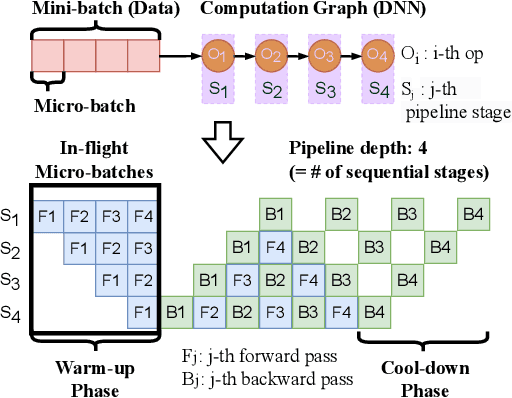

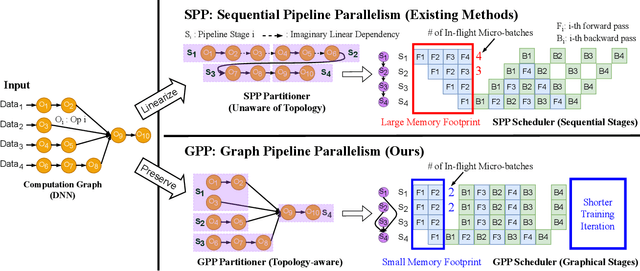
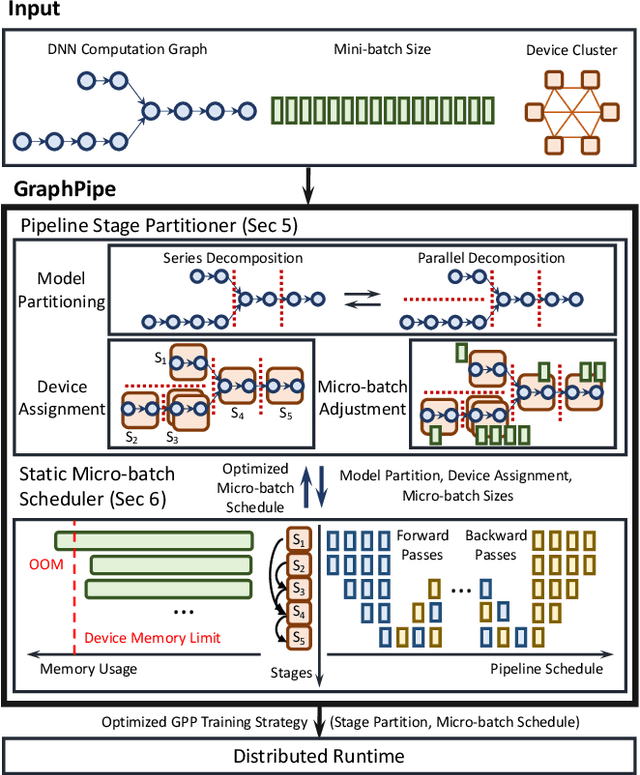
Abstract:Deep neural networks (DNNs) continue to grow rapidly in size, making them infeasible to train on a single device. Pipeline parallelism is commonly used in existing DNN systems to support large-scale DNN training by partitioning a DNN into multiple stages, which concurrently perform DNN training for different micro-batches in a pipeline fashion. However, existing pipeline-parallel approaches only consider sequential pipeline stages and thus ignore the topology of a DNN, resulting in missed model-parallel opportunities. This paper presents graph pipeline parallelism (GPP), a new pipeline-parallel scheme that partitions a DNN into pipeline stages whose dependencies are identified by a directed acyclic graph. GPP generalizes existing sequential pipeline parallelism and preserves the inherent topology of a DNN to enable concurrent execution of computationally-independent operators, resulting in reduced memory requirement and improved GPU performance. In addition, we develop GraphPipe, a distributed system that exploits GPP strategies to enable performant and scalable DNN training. GraphPipe partitions a DNN into a graph of stages, optimizes micro-batch schedules for these stages, and parallelizes DNN training using the discovered GPP strategies. Evaluation on a variety of DNNs shows that GraphPipe outperforms existing pipeline-parallel systems such as PipeDream and Piper by up to 1.6X. GraphPipe also reduces the search time by 9-21X compared to PipeDream and Piper.
Pollux: Co-adaptive Cluster Scheduling for Goodput-Optimized Deep Learning
Aug 27, 2020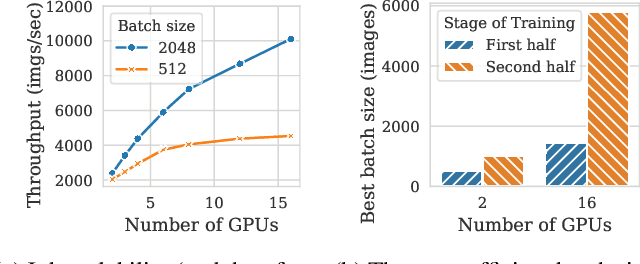



Abstract:Pollux improves scheduling performance in deep learning (DL) clusters by adaptively co-optimizing inter-dependent factors both at the per-job level and at the cluster-wide level. Most existing schedulers will assign each job a number of resources requested by the user, which can allow jobs to use those resources inefficiently. Some recent schedulers choose job resources for users, but do so without awareness of how DL training can be re-optimized to better utilize those resources. Pollux simultaneously considers both aspects. By observing each job during training, Pollux models how their goodput (system throughput combined with statistical efficiency) would change by adding or removing resources. Leveraging these models, Pollux dynamically (re-)assigns resources to maximize cluster-wide goodput, while continually optimizing each DL job to better utilize those resources. In experiments with real DL training jobs and with trace-driven simulations, Pollux reduces average job completion time by 25%-50% relative to state-of-the-art DL schedulers, even when all jobs are submitted with ideal resource and training configurations. Based on the observation that the statistical efficiency of DL training can change over time, we also show that Pollux can reduce the cost of training large models in cloud environments by 25%.
Accelerating Deep Learning by Focusing on the Biggest Losers
Oct 02, 2019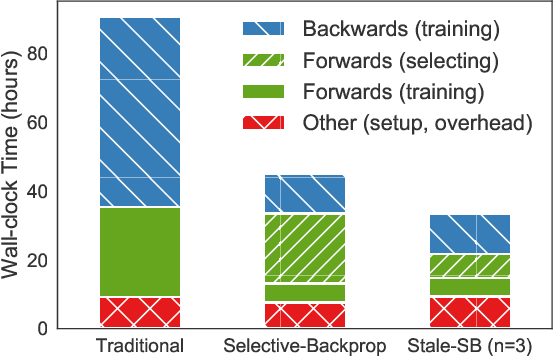


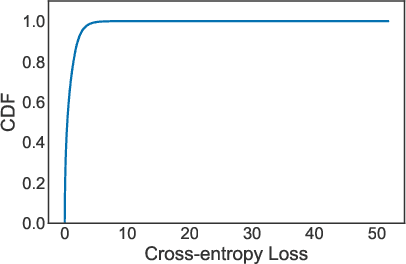
Abstract:This paper introduces Selective-Backprop, a technique that accelerates the training of deep neural networks (DNNs) by prioritizing examples with high loss at each iteration. Selective-Backprop uses the output of a training example's forward pass to decide whether to use that example to compute gradients and update parameters, or to skip immediately to the next example. By reducing the number of computationally-expensive backpropagation steps performed, Selective-Backprop accelerates training. Evaluation on CIFAR10, CIFAR100, and SVHN, across a variety of modern image models, shows that Selective-Backprop converges to target error rates up to 3.5x faster than with standard SGD and between 1.02--1.8x faster than a state-of-the-art importance sampling approach. Further acceleration of 26% can be achieved by using stale forward pass results for selection, thus also skipping forward passes of low priority examples.
SysML: The New Frontier of Machine Learning Systems
May 01, 2019Abstract:Machine learning (ML) techniques are enjoying rapidly increasing adoption. However, designing and implementing the systems that support ML models in real-world deployments remains a significant obstacle, in large part due to the radically different development and deployment profile of modern ML methods, and the range of practical concerns that come with broader adoption. We propose to foster a new systems machine learning research community at the intersection of the traditional systems and ML communities, focused on topics such as hardware systems for ML, software systems for ML, and ML optimized for metrics beyond predictive accuracy. To do this, we describe a new conference, SysML, that explicitly targets research at the intersection of systems and machine learning with a program committee split evenly between experts in systems and ML, and an explicit focus on topics at the intersection of the two.
MLtuner: System Support for Automatic Machine Learning Tuning
Mar 20, 2018

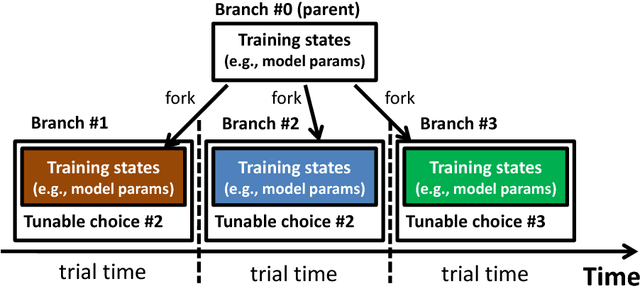

Abstract:MLtuner automatically tunes settings for training tunables (such as the learning rate, the momentum, the mini-batch size, and the data staleness bound) that have a significant impact on large-scale machine learning (ML) performance. Traditionally, these tunables are set manually, which is unsurprisingly error-prone and difficult to do without extensive domain knowledge. MLtuner uses efficient snapshotting, branching, and optimization-guided online trial-and-error to find good initial settings as well as to re-tune settings during execution. Experiments show that MLtuner can robustly find and re-tune tunable settings for a variety of ML applications, including image classification (for 3 models and 2 datasets), video classification, and matrix factorization. Compared to state-of-the-art ML auto-tuning approaches, MLtuner is more robust for large problems and over an order of magnitude faster.
 Add to Chrome
Add to Chrome Add to Firefox
Add to Firefox Add to Edge
Add to Edge